
|
Martin B-26 Marauder |
 |
||||||||
|---|---|---|---|---|---|---|---|---|---|---|
 |
 |
 |
 |
 |
 |
 |
 |
 |
 |
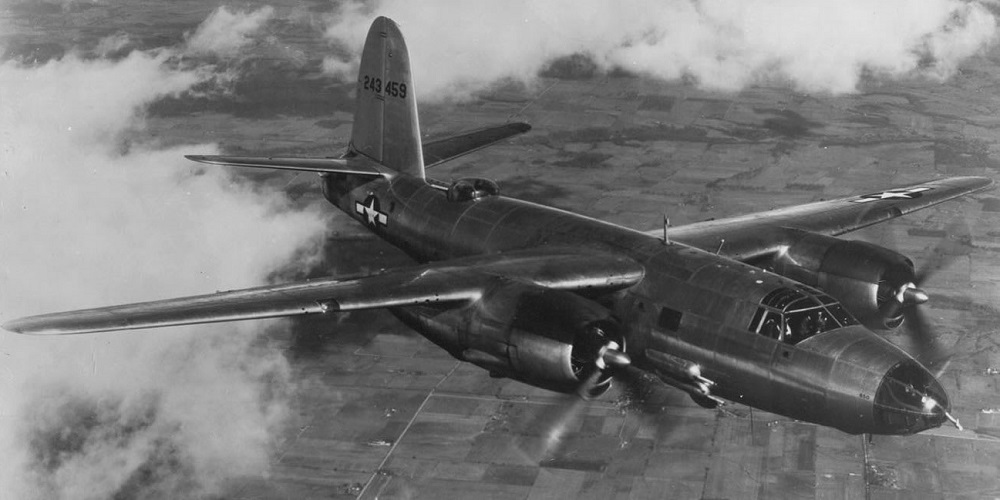
| |||||||||
|
In 1939, the Martin B-26 Marauder was built in parallel with North American B-25 Mitchell, however while the B-25 was a docile handling airplane, the B-26 was nothing of the kind. It was built for speed and was a highly strung, unforgiving airplane, that needed to be tamed by the most experienced pilots. At 56 lbs/ft2, it had the highest wing loading of any American World War II airplane—40% higher than that of the B-25.1 While such wing loading is now considered the industry standard, World War II aircraft lacked the sophisticated automatic braking and propeller feathering systems currently available today, thereby making accidents more likely.
It was rushed into service, overloaded with equipment without increasing power and put into low level ground attack missions it was not designed for. It experienced engine and propeller failures beyond Martin’s control, which contributed to its poor reputation. It was susceptible to flak because of its overloaded wing and could not sustain much battle damage. It suffered badly on low level ground attack missions, but when used as a medium level bomber, which it was designed for, its performance greatly improved. After teething problems with mechanical systems were worked out and pilots were better trained, its loss rate diminished and was comparable to the minimum rates of other aircraft in service. The B-26 was created by engineer Peyton M. Magruder of the Glenn L. Martin Company. It was designed with a near perfect streamlined fuselage, except for the stepped windshield. It had a shorter wing to give it a higher maximum speed, but there was a trade-off. The landing approach speed was much greater than most pilots would have been use to at that time and the short wing reduced durability in combat. |
| For the unwary pilot, it could be a deathtrap. In the rush to gear up for the war, it was hastily entered into service and was flown by inexperienced pilots. It was nicknamed the Widow Maker, the Baltimore Whore, the Flying Prostitute (because it had no visible means of support), and One a Day in Tampa Bay, after 15 crashes in one 30-day period. With a landing speed of 140 mph (225 km/h), it was too much airplane for the novice to handle.2 |
|
On March 11, 1939, the United States Army Air Corps (USAAC) issued Circular Proposal 39-640 for a twin-engine bomber with the following specifications:
• Provisions for a five-man crew. Four bids were accepted from Martin, North American, Douglas and Stearman and the first three were declared winners. Martin submitted its Model 179 and it was evaluated as superior to all other proposals and an order for 201 aircraft was awarded on August 9, 1939. It was the first aircraft ordered off the shelf (from the drawing board) without the usual requirement to build a prototype and proving through flight testing. A further order was issued for an additional 930 B-26s in September 1940, before the first aircraft had even flown. The Army was demanding a lot, since military aircraft typically required approximately three years to perfect. The inaugural flight was on November 29, 1940 and the performance was as follows:
• Service ceiling of 25,000 ft (7,620 m). It was powered by two 1,850 hp (1,380 kW) Pratt & Whitney R-2800-5 engines and with the aircraft being considered satisfactory, it was accepted by the USAAC on February 8, 1941.3 Initially, it showed little need for modification except for some rudder over-balance. The shoulder mounted wings were unusual in that they had no fuselage filets. The frameless Plexiglas nose dome was a Martin innovation and had a flexible mount for a single 0.30 caliber machine gun and a similar gun was mounted in the tail cone. These guns were later change to 0.50 caliber machine guns to match the two guns in the electrically operated dorsal turret that had been developed on the sole Douglas A-20F Havoc,4 making the Marauder the first American production bomber to be equipped with a powered turret. Also an advanced feature was was long, full-feathering, four-blade Curtiss electric propellers with root cuffs to aid in engine cooling. However, the long blades provided very little ground clearance and the airplane was limited to improved runways only.5 Hastily entered into service, it experienced a high rate of accidents and landing gear failures. It came under the scrutiny of the Truman Commission and a special military board grounded the plane in April 1941, to decide whether it would remain in production. The Curtiss propellers were a problem for the Marauder which caused several crashes. The props would fail and flatten out and go into a runaway condition. This was particularly dangerous when it happened during takeoff. Rumors circulated that the airplane couldn’t fly on one engine and pilots were refusing to fly the airplane. To protect their reputation, Martin made an all out effort to restore confidence in the airplane. They brought in the famous stunt pilot, Vincent "Squeak" Burnett and Jimmy Doolittle to promote the airplane and in a B-26 training film, actors portrayed how easy it was to fly the plane on one engine.6 Years later Jimmy Doolittle recalled, “The B-26 was an unforgiving airplane and it was killing pilots because it never gave them a chance to make mistakes. General Arnold wanted me to check into the problem and recommend whether it should be continued to be built or not. I checked it over, flew it and liked it. There wasn’t anything about its flying characteristics that good piloting skills could overcome. I recommended that it be continued to be built and it was.”7 The airplane was redesigned with an increased wing span of 71 ft. (22 m) from 65 ft. (20 m) with a corresponding increase in wing area of 659 ft2 (61 m2) from 602 ft2 (56 m2). The vertical stabilizer was increased in height to compensate for the longer wing span. The longer wing was added on the 982nd aircraft from the Baltimore plant and on the first Omaha built B-26C. On later models, the angle-of-incidence was increased and the nose gear was raised for better takeoff performance, which also increased the propeller ground clearance. Landing gear problems were corrected by an improved heat treatment process of metal components and the hydraulic system was improved. Rather than closing the landing gear doors hydraulically, they were simplified and linked to the gear. After corrections were made to the design and crews were provided additional training, the board recommended continuance of production.
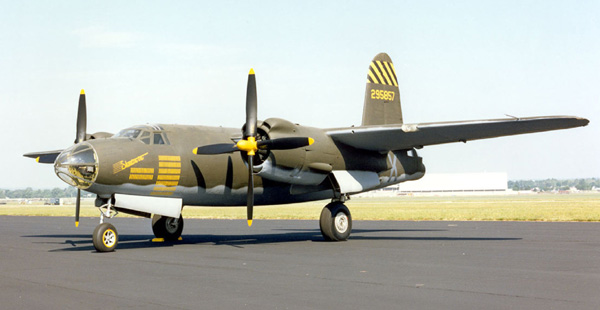
The 22nd Bombardment Group in Langley Field, Virginia was the first group to be equipped with the Marauder and they left for Australia, on December 8, 1941, one day after Pearl Harbor was attacked. The planes were shipped to Hawaii then reassembled and flown to Australia. The first operations were against targets in New Guinea and they flew regularly against targets in Rabaul, with intermediate stops in Port Moresby for fuel. In June 1942, B-26As made their debut as torpedo-strike aircraft against Japanese shipping in Midway and in the Aleutians, but scored no hits. The Marauders in the Pacific were eventually replaced with B-25s which were more suitable for island-hopping, operating from shorter rugged runways. The 73rd and 77th Bombardment Squadrons operated their Marauders from Alaska, but the weather was more of threat than the enemy with Marauders having to perform most of their missions through dense fog.8 Although the combat career of the Marauder began in the Pacific, it achieved its main successes in Europe and North Africa. B-26s were shipped to Great Britain for evaluation and were designated Marauder Is. They were used as tactical aircraft and 52 Marauder Is were shipped directly to the Middle East for use by the RAF's No. 14 Squadron becoming operational in early 1943. The B-26 also served with 39th, 326th, 327th and 454th Squadrons of the RAF.
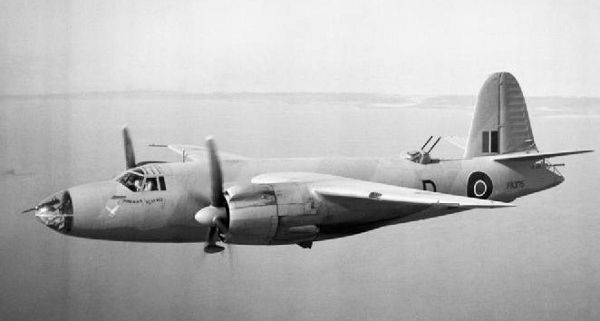 A Marauder I of the RAF No. 14 Squadron. At the end of 1942, the 17th, 319th and the 320th Bombardment Groups of the 12th Air Force operated B-26B and Cs in tactical operations in North Africa. Marauders were used in the Tunisia campaign as long-range fighters to shoot down Me 323 and Ju 52 transports in droves far out over the Mediterranean. With the 8th Air Force in England, the Marauder had far less success in its designed bomber role. On May 17, 1943, during a mission to bomb installations in the Netherlands at Ijmuiden and Haarlem, all eleven Marauders (one airplane aborted for mechanical failure) were shot down by flak and fighters. After the failure of that mission, there was very little enthusiasm from the 8th Air Force for the Marauder. Not only did it have a different performance envelope from the Boeing B-17, it also proved that it was incapable of defending itself in the hostile European skies and highly vulnerable to flak. Flak was a serious problem for the Marauder as it was for the same reason as the B-24 Liberator. Both aircraft had highly efficient airfoils and could not withstand much damage to the wings and continue to fly. In comparison, the wing B-17 Flying Fortress had a much lower wing loading than the B-24 and B-26. The extra wing area made the B-17 less efficient, but it was able withstand greater battle damage to the wings and still get its crews back home. It was with the 9th Air Force where the B-26 proved its mettle. Just before D-Day, the Marauder became the first USAAF aircraft in Europe to operate at night and began precision attacks against bridges and transports. As they started operating from Continental airstrips, they flew 29,000 sorties and dropped 46,430 tons of bombs for a loss of only 139 aircraft, and later would have the lowest attrition rate of any aircraft of operated by the 9th Air Force. The Free French, Australians, and Canadians also flew the B-26 in the three main theaters of combat. With the South African Air Force, they flew with the 12th, 21st, 24th, 25th and 30th Squadrons. By the end of World War II, B-26 crews had flown more than 110,000 sorties and had dropped 150,000 tons of bombs.
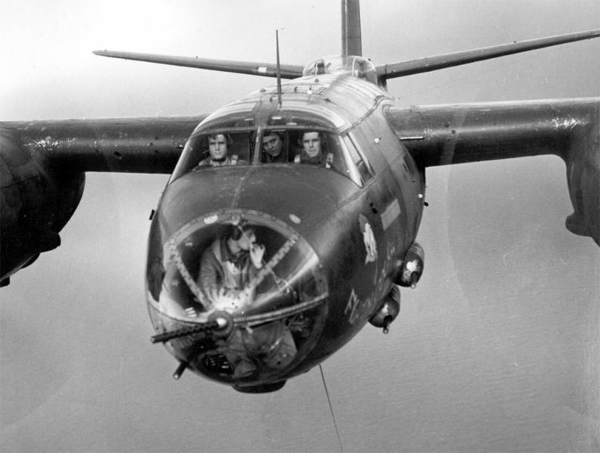 Later models of the Marauder had as many guns as the Boeing B-17 Flying Fortress and as many fixed guns as some fighter aircraft. With the introduction of the B-26B-10, the Marauder had evolved into another Flying Fortress. After the installation of twelve 0.50 caliber machine guns, it bristled with as much armament as the Boeing B-17. The flexible nose gun was changed to 0.50 caliber with another fixed nose gun on the starboard side. Two package guns were mounted in blisters on either side of the fuselage, below and behind the cockpit, which gave the Marauder almost as many fixed guns as some fighters. Another turret was added to the tail, matching the guns of the powered dorsal turret and two guns were added at the waist positions.9 With the development of the G Model, the forward fixed nose gun was removed, reducing the total compliment of guns to eleven. Pathfinders The 9th Air Force operated Marauder bomb squadrons, designated Pathfinders (PF), and was a highly secretive operation used for nighttime and bad weather bombing operations. They marked targets for heavy bombers in weather that otherwise would not allow for bombing missions. They used an RAF radar system that had been developed for use on de Havilland Mosquitoes. The RAF developed several electronic aerial navigation systems, called Gee, Oboe and HS-2 radar for greater nighttime bombing accuracy. The 9th Air Force Pathfinders utilized the Oboe systems that was supplied by the RAF and very little information was divulged to the Americans other than how to operate the system.
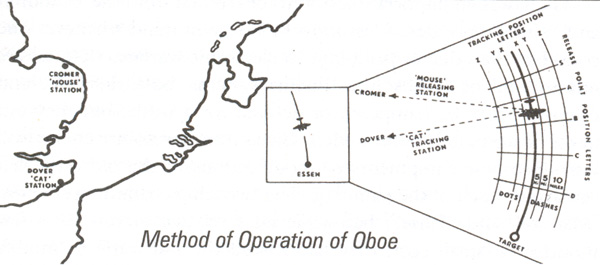 Image from Instruments of Darkness by Dr. Alfred Price. The Oboe system operated by sending an electronic signal from two well-seperated towers located in Dover and Cromer, England. The two beams would create a circular path only 35 yards wide and intersect over the target area. If the plane went to the left a series of dots would sound (Morse Code E). If the plane moved to the right, a series of dashes would sound (Morse Code T). When the aircraft maintained a course on the path, a steady hum would be audible. As the airplane approached the target, four lights would be illuminated on the pilot’s and bombardier’s panel and operated as follows:
• 1st light - Initial Point reached. The PF missions weren’t popular with Marauder crews as it required formation flying in foul weather, which was risky on its own merit, and the bomb runs could be as long as five minutes, which was an invitation to flak. The only noticeable difference between a pathfinder and a standard Marauder was a 4 inch diameter by 4 foot long Plexiglas Oboe antenna located beneath the fuselage forward of the waist gun. The receiver was located in the radio compartment. Since it was British invention, it was maintained solely by the RAF. The accuracy was said to be accurate within 300 feet. The only drawback to the Oboe system was that it could only track one airplane at a time.10 The 322nd PF squadron was stationed in Braintree England and consisted of 18 Oboe equipped Marauders. The 322nd later moved to Beauvaix-Tille France. Other PF squadrons were the A-72 at Perone with the 397th and the Y-55 in Venlo Holland with the 394th and 397th. Pathfinders equipped the 9th Air Force with approximately 50 percent of its capability to bomb targets in the critical winter weather of 1944-45. After V-E Day, the squadrons were disbanded and gone with hardly a trace.11 It took time for those who assigned missions for the Marauder to understand the limits of the airplane. In war, hasty decisions are made and mistakes are made. Although decision makers know better, they often had no other choice than to use what was available. B-26 production ended in 1945 with a total of 5,266 aircraft being produced and its tarnished reputation stayed with the airplane. Most Marauders were unceremoniously scrapped, leaving few survivors behind. As hastily as it was put into service, it was removed just as quickly, being overshadowed by the Douglas A-26 Invader. |
| Specifications: | ||
|---|---|---|
| Dimensions: | ||
| B-26A | B-26C | |
| Wing span: | 65 ft 0 in (19.81 m) | 71 ft 0 in (21.65 m) |
| Length: | 56 ft 0 in (17.06 m) | 58 ft 3 in (17.80 m) |
| Height: | 19 ft 10 in (6.06 m) | 21 ft 6 in (6.55 m) |
| Weights: | ||
| Empty: | 21,375 lb (9,695 kg) | 24,000 lb (11,000 kg) |
| Takeoff Weight: | 27,200 lb (12,337 kg) | 38,200 lb (17,327 kg) |
| Performance: | ||
| Maximum Speed: | 315 mph (507 km/h) | 282 mph (454 km/h) |
| Service Ceiling: | 25,000 ft (7,620 m) | 21,000 ft (7,163 m) |
| Normal Range: | 1,000 miles (1,609 km) | 1,150 miles (1,850 km) |
| Powerplant: | ||
|
Two 1,850 hp (1,380 kW) Pratt & Whitney R-2800-39 engines. |
Two 2,000 hp (1,490 kW) Pratt & Whitney R-2800-43 engines. |
|
| Armament: | ||
| Two 0.50 caliber machine guns. Two 0.30 caliber machine guns. 3,000 lb (1,360 kg) bombs in an internal bay. | Twelve 0.50 caliber machine guns. 4,000 lb (1,800 kg) bombs in an internal bay, 22 inch Mark XIII torpedo. | |
Endnotes:
|
1. David Mondey. The Concise Guide to American Aircraft of World War II. New York: Smithmark Publishers, 1982. 184. 2. Pilot's Flight Operating Instructions for Army Models B-26F and B-26G Airplanes. Chicago: Marshall-White, 1944. 33. 3. Ray Wagner. Aircraft in Profile, Volume 5. Garden City, New York: Doubleday & Company, Inc., 1969. 112-4. 4. E. R. Johnson. Havoc! Aviation History. September 2004. 27. 5. William Green. Famous Bombers of the Second World War. Garden City, New York: Doubleday & Company, Inc., 1975. 195. 6. David Fortuna. Vincent 'Squeak' Burnett: Daredevil Acrobat Goes to War. Aviation History January 2006. 7. Carrol V. Glines. Jimmy Doolittle, Master of the Calculated Risk Van Nostrand Reinhold Company, 1980. 125-126. 8. Ray Wagner. American Combat Planes. Garden City, New York: Doubleday & Company, Inc., 1982. 225. 9. Kenneth Munson. The Pocket Encyclopedia of World Aircraft in Colour, Bombers 1939-45. London: Blanford Press. 1969. 125. 10. Dr. Alfred Price. Instruments of Darkness. London: Greenhill Books, 2005. 120. 11. J. K. Havener. The Martin B-26 Marauder. Blue Ridge Summit, PA: Tab Books Inc., 1988. 228. |
©Larry Dwyer. The Aviation History Online Museum.
All rights reserved.
Created March 26, 2014.
Revised August 13, 2018.